SHANGHAI
Shanghai is China’s largest city with more than 13 million residents. It is an autonomous municipality with a colorful recent history and a vibrant presence in today’s China and beyond.
Shanghai is on the eastern coast of central China. It is situated north of the Yangtse River, and it spans the Huangpu Rive
Shanghai became a minor county seat in the 13th century, and it remained a small provincial town until the mid-19th century when Britain demanded trade access to China’s east coast and went to war with China to obtain it. In 1842, the ensuing Treaty of Nanking gave the Brits trading rights with certain ports including Shanghai.
However, in addition to becoming a trading port, Shanghai also became an outpost of high living. Parts of the city were divided into “concessions” where foreign nationals lived in miniature versions of Britain, France, and the United States. These areas were ‘extra-territoriality’ meaning that foreign residents were answerable only to the laws of their own countries, and each concession had its own police and judiciary. This enabled some of the excess and criminality the contributed to Shanghai’s reputation, and Shanghai remained politically combustible between the world wars. Chinese opposition to the concessions grew, and they ended in the 1940s.
Shanghai was the site of much political power during the 1940s. Shanghai was where the first Chinese Communist Party met. However, when the communists took power in 1949, Shanghai was stripped of its previous glamour. Shanghai is also from where the Cultural Revolution and notorious ‘Gang of Four’ evolved, but it was a large rundown metropolis by 1976 when Mao died.
Since the 1990s, Shanghai has experienced tremendous growth in economic and industrial development. It is, in fact, one of the fastest growing cities in the world.
Today’s Shanghai can be seen as having three main areas: the old city, the concession areas, and the Pudong. Each has its own personality.
The old city is the southeast part of the city. This is the more traditional Chinese area with alleyways, markets, and temples. This is also the site of the spectacular Yu Gardens.
The concession areas are west and north of the old city. The French concession area is in the southwest, and the British and American concession areas are in the north. The Bund – the waterfront area along the western side of the Huangpu River – is still lined with colonial buildings and reflects the British influence in the early 20th century when Shanghai was the third largest financial center in the world.
The Pudong, Shanghai’s newest area, is on the eastern bank of the Huangpu River. It was declared a “special economic zone” in 1990, and it is greatly contributing to Shanghai’s revival. Investments have poured in, and the Pudong is already home to some of the world’s highest buildings.
Today’s Shanghai, and especially the Pudong area, is presented to the visitor as a symbol of the “new” China’s vitality and dynamism. But the less vital and less dynamic underbelly is still glaringly obvious to those that wander even slightly off the beaten track.
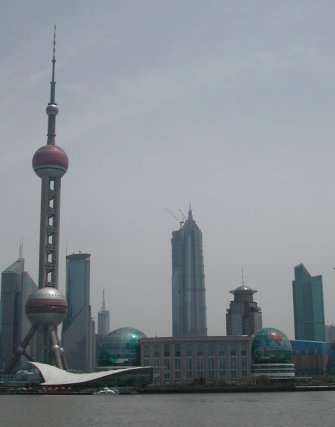
The Pudong after a cleansing rain
Our first stop in Shanghai was the Bund – also called Zhongshan Lu. The Bund is the north-south walk along the west shore of the Huangpu River. To the east is the river, and merely across the street to the west are colonial buildings mostly dating from the 1920s. When we arrived, the air pollution was so thick that we could not see the famously tall buildings across the Huangpu River which is about 400 yards wide at that part. Nor could we see the tops of the lesser buildings near which we stood or those more than one block away. The air was not fit to breathe.
We got a cold drink and wandered only as far as visiting Chen Yi’s statue. Chen Yi was a revolutionary commander and the first mayor of Shanghai after 1949. It was refreshing to find a tribute to someone other than Mao. But the pollution was more than we could endure, and we left.
By luck (good or bad?), we had a heavy rainfall a few days later, and Nita again wandered down to the Bund (this was one of Bud’s sick days). Although not crystal clear, the Pudong and the tops of the westside buildings were visible. The air is intolerable without the benefit of a heavy rain.
The Shanghai Museum was far less impressive than the Shaanxi History Museum in Xian, but it was worth the time spent there. The Shanghai Museum houses approximately 120,000 pieces (less than 1/3 that of the Shaanxi History Museum) spanning about 5,000 years from the neolithic period to the Qing dynasty. The building itself, however, is thoroughly unattractive and inconsistent with most other architecture we saw throughout China.
We drove through Old Town, and it was refreshing to see some of ‘old’ China within a cosmopolitan city like Shanghai. However, as Nita discovered a few days later, we were shown a relatively sanitized part of Old Town. One does not have to look very hard to see the poverty that blankets much of this traditional part of the city.
Other than a few historic buildings, this area offered no special attraction. The few remaining historic buildings have been converted to overpriced restaurants or shops. Anything unique to its prior French inhabitants has been glossed over by its 21st century marketing.
This, too, is a state-run outlet, and we should have known better. But Nita really really wanted to go see what she could learn and maybe even buy a scrap or two or silk.
We were greeted by a woman with an annoying voice, mannerism, and speech habits. She was the ‘gatekeeper’ we had to endure to see more of the silk factory. But, as hoped, we did learn a lot.
In addition to learning about the life cycle of silkworms and the process of making silk, we learned some memorable trivia about Chinese resourcefulness and silk worms. The Chinese are highly resourceful, and they waste nearly nothing. Such is true in their use of silkworms. While silkworms are maturing, their poo is collected and sewn in to sachets that are kept under one’s pillow while sleeping. We both remember that they do this, but neither of us can remember why. Also, after silkworms have produced their filament, the grubs are cooked and eaten. We neither bought a sachet nor ate a fried grub, but we did buy one little scrap of fabric.
This outlet specialized in duvet-like bed covers made of layers of silk fibers. They seemed quite nice, and they were reasonably priced, but they are not boat items. Nita did get one piece of silk brocade that was not inexpensive, but it is very nice.
We also browsed their ‘ready made’ store, and we developed sticker shock. Nita wanted a simple pair of black silk pajamas, and she found a pair she liked for a mere 680 yuan – the rough equivalent of $113 AUD or $91 USD. This is our factory discount?
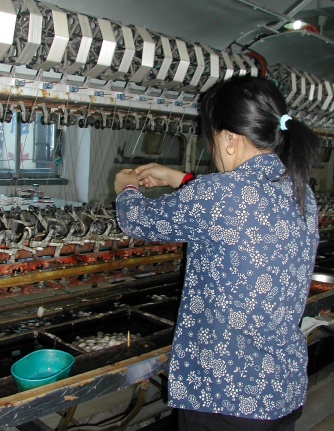
Spinning silk filament in to thread
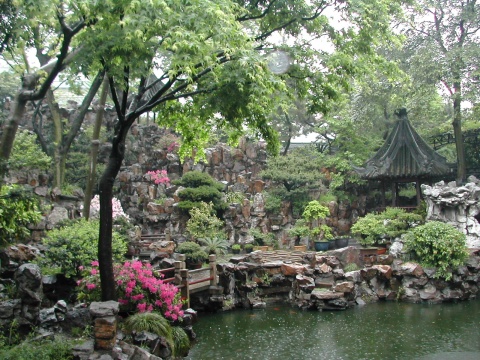
Part of the spectacular Yuan Gardens
Chinese gardens are more than a collection of plants. They are a synthesis of scenery and serenity. Gardens should improve on nature using four necessary elements: plants, water, rocks, and buildings. These elements are used to create specific views as well as items viewed. The Yuan Gardens are a spectacular example of Chinese gardens.
It was pouring rain the day we visited the Yuan Gardens. Consequently, we felt a bit rushed. There was some umbrella warfare among those behind us that feared getting wet, but we enjoyed as much as we could given the conditions.
Walls divide the Yuan gardens in to six areas. This creates a feeling of more space than the gardens actually occupy. It also creates the urge to linger in each. Each is beautiful, and some are breathtaking.
Of course there are plants. And there is water – some running and some still. Rocks have been used throughout, and there is a particularly interesting rockery intended to recall the caves and gorges of southern China. And there are numerous small buildings.
We had hoped that the rain would lessen the crowds at the gardens, but it only seemed to hasten their frenzied pace. Maybe the gardens could be better enjoyed in the early morning? These should not be rushed through.
Outside the Yuan Gardens is a large and charming bazaar. There are some eateries and many shops. Nita had hoped to do some shopping here, but the rain frenzy among the crowd made that impossible. This would be a great place to spend more time.
Nita went on an evening river cruise on the Huangpu River in pouring rain while Bud took a sick evening. Standing in any line in China is an interesting experience (they have a much smaller sense of personal space than westerners), but the addition of umbrella warfare made it a bit of a challenge. But she prevailed, and not only got on the boat, but she got a place to stand outside yet out of the rain (ok, the diesel fumes were a bit thick).
Despite the rain, seeing the Bund at night from the river was beautiful. Darkness and rain did wonders to make the city appear fresh and clean.
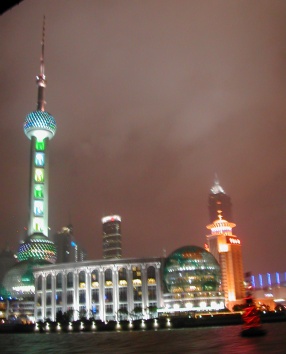
Pudong at night
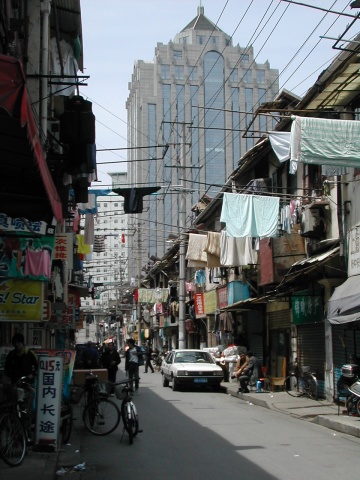
Contrast of new and old
City Walk – Bud still felt miserable the following day, and Nita was feeling well enough to go out, so she went on a six hour walk through some interesting parts of Shanghai. She revisited the Bund, but most of her miles were through Old Town.
The prior day’s rain had left the skies relatively clear, and it was a pleasure to walk along the Bund. Buildings across the river and ahead were visible. The entire area seemed less depressing with cleaner air to breathe.
Many fortuitous wrong turns created an interesting – albeit lengthy – walk through Old Town. There are ‘theme’ shopping areas in which an entire block will be shops selling buttons, then another block will be wedding dresses, and then the next block will be auto parts or whatever. It seems highly practical for the shopper whom knows their way around.
There is a lot of urban poverty behind the glitzy façade of Shanghai. Countless urban side streets are low income housing on the upper level above a shop below.
There is also a lot of community activity. Some of the activity was probably paid work – such as recycling bricks, a national obsession – but much of it appeared recreational. There was a lot of laughter that was notably absent in Beijing. It was wonderful to see beyond the prescribed itineraries intended for tourists.
Dinner Show – This show opened with two boys on roller skates, and it got consistently worse. A few attractive young girls whom could not sing a note came out and strutted around while howling a bit, and we both felt quite badly for them. It must have been a humiliating experience for them.
This show might have some appeal for some teenagers, but it was a dreadful choice for a group of semi-intelligent western adults. We wish we could remember the name of the dinner theater, but we both seem to have erased it from our memories.
It was time to leave China and return to Passage in Bundaberg, Australia. We were both sick and tired, so we were ready to get home. What a trip!